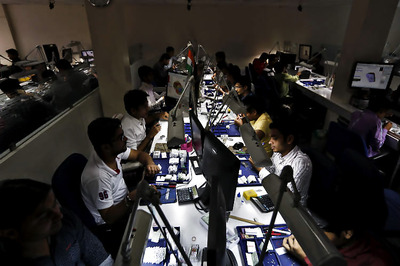
views
KOCHI: When the reverend Thomas Robert Malthus observed a couple of centuries ago that population finds its level based on fertility rates, famine and diseases, he could not have imagined that the last two factors, namely famine and diseases, could be eradicated in such a spectacular manner as has been realized in recent times. In such a changed context, the fertility factor if unchecked could trigger a population explosion far surpassing possible growth in livelihood, thus making life difficult and progress impossible. Hence the need to control population by downsizing the family.Such need was most keenly felt in independent India which had a fast-growing population living at subsistence level. Hence the justification for state intervention in controlling fertility to adjust to the new realities. And it was India that took initiative first among the countries in 1952 under the visionary leadership of Jawaharlal Nehru, towards adopting population control as a state objective. At the same time, social norms were changing. Joint family system gave way to nuclear families, and women began to work for money. It became difficult for working couples to look after more children. And all of a sudden a competitive culture burst upon society. Children demanded attention, not only in material terms but equally so in emotional terms. Their educational and healthcare demands have made each child a precious project to be taken up with delicate care.If children are God’s gift to parents, what they make out of the children has to be their return gift to God. And it becomes difficult for parents to give themselves to their children if their number exceeds a critical level; and two is considered by most parents as the optimum.Therefore, if population control is a state objective, then family downsizing is a keenly felt need of the people.That means there is no quarrel between the state and the citizen. What the state thinks at the macro level, the people want at their personal level. To go by a saying in Malayalam, what the doctor has prescribed and what the patient had eagerly desired happen to be the same. So, what the state is required to do is to create the needed ambience to help people achieve their goal of two-child family. That being so, why the state and its spokespersons often take self-righteous stands and become indignant and intolerant whenever they fancy that people might transgress their own self-accepted ‘norm’ unless under constant threat of penalties? And why is the strident tone often adopted by state agencies and even well-meaning lawyers to express their disapprovals in the matter?This habitual intolerance is exemplified in the recommendations of the Kerala Law Reforms Commission headed by V R Krishna Iyer for the purpose of protecting the interests of women in the state. It had recommended that any movement, campaign or project which would stand against the said norm would attract penalty. And there are lawyers who would uphold this kind of recommendations, unmindful of the fact that they have become anachronistic and redundant in the context of states like Kerala. (See the article on the subject that appeared in TNIE on 7/11/11.)Kerala is the one state in India which has recorded decadal growth in population below 10 percent. Its growth rate was 9.43 percent during 1991-2001 and still lower at 4.86 percent in 2001-11, matching with developed countries in the world (e.g. USA: 7.26 percent and China: 5.43 percent). The growth percentages at pan-India level were 21.54 in 1991-2001 and 17.64 in 2001-11. Then why this legal activism in Kerala?In the article cited above, there are justifying references to judgments upholding state cruelties to employees who had ‘violated’ the two-child norm. There is mention of a Supreme Court order upholding the termination of services of an air- hostess because she became pregnant for the third time in violation of her service rules. Instead of declaring the rule draconian and unconstitutional, the court upheld her termination of service on the grounds that, paraphrased, she was unfair to the country by adding to its burgeoning population!It may be observed that India’s decadal population growth has come down from 24.8 percent (in 1961-71) to 17.64 percent now. (The improvement was better in the case of southern India and the adjacent states of Maharashtra and Orissa). This reflects people’s realization of the benefits from smaller families and not from any imposed norm. Compulsory sterilization attempted by the Government during the Emergency misfired because it went against the grains of the people; in fact it only caused to harden their attitudes although for a short while. (If China lifts its dictatorial grip on its population, that moment there could be a backlash and the population may grow berserk for a while.)Therefore, it is time the state plainly recognized the premises that family size is the prerogative of the parents, that people are increasingly realizing the benefits of the small-sized family, that they would self-adjust accordingly and that the government’s role be limited to educating/sensitizing the people about its macro implications and providing conducive ambience. Of course, there are rural pockets in India especially in the North where this realization is yet to strike roots - areas marked by higher fertility and mortality indicators. According to a recent report of the National Health Survey covering 284 districts in the country, there are severely handicapped districts in places like UP where the crude birth rates and death rates are several times higher than in neighbouring districts. For instance, while the birth rate in Bageshwar district in Uttarakhand is 14.7 children per population of 1000, it is 40.9 in Shrawasti in the neighbouring UP. If the death rate in Dhemaji district in Assam is 4.5 per population of 1000, it is 12.6 in Shrawasti. Rudraprayag in Uttarkhand reported infant mortality rate of 19 per 1000 live births; it is 103 in Shrawasti.Obviously places like Shrawasti need government’s special attention in the form of education and healthcare. Once this is ensured and development takes place, people could be expected to be sensitized about their family’s welfare in the modern sense; and family downsizing will naturally follow. Surely, crude pressure from the state will not yield the desired results from under-developed areas such as Shrawasti.To summarise, family sizing is primarily the family’s concern.In the modern context, people increasingly realize the benefit of small families, and they will adjust themselves accordingly, thereby ensuring national interests too in the process. No developed country in Europe or America had to apply state pressure to bring about the desired result.(The writer is former Executive Director, IDBI. The views in the article are the author’s own).



















Comments
0 comment